How to Build a Diversified Investment Portfolio (With 5 Examples)

Diversification is about not putting all your eggs in one basket.
Simply put, you can reduce your portfolio's risk by diversifying your money into multiple investments. While it may sound complicated, it's actually pretty simple.
You want to own assets with uncorrelated performance, so everything in your portfolio isn't going up or down at the same time.
Most well-diversified portfolios are a mix of stocks, bonds, and cash. And you can achieve proper diversification with just 3–5 investments.
Plus, that's how several billionaire investors recommend you invest.
Below is a complete overview of how to balance risk and reward, a look at asset classes, and five examples of diversified portfolios.
A note on complexity
Before diving in further, it's worth mentioning the following:
It's easy for investors to overcomplicate their portfolios. People assume complexity = sophistication. But it doesn't.
In investing, simplicity is the true form of sophistication.
Disclaimer: This is not investment advice. This article reflects my opinions based on my knowledge and experience. There are many nuances that I cannot cover in this article. Before investing, always do your own research and due diligence.
Risk tolerance and asset allocation
As an investor, your goal is to balance risk and reward.
To accomplish this, many investors invest in a combination of stocks and bonds. How an investor diversifies (the mix of investments chosen) is known as asset allocation.
You can achieve higher returns by investing in stocks. But stocks also come with larger drawdowns and a greater chance of losing money.
Bond investments, on the other hand, are less volatile but come with lower returns.
Remember, the goal of diversification is not to maximize returns. The goal is to reduce the level of volatility (big price changes up or down) in a portfolio.
You can shape your portfolio's expected risk/reward by changing the amount of money you allocate to stocks and bonds.
The more you allocate to stocks, the higher your portfolio's expected risk/reward. The more you allocate to bonds, the lower your portfolio's expected risk/reward.
If you're a younger investor, you have a longer investing horizon, so your portfolio has more time to bounce back from stock dips. You can allot a higher percentage of your portfolio to stocks. However, the reverse is true as you get closer to retirement.
For this reason, many investors shift their asset mix toward less risky investments as they get older. A simple rule of thumb is to allocate your age (in percentage terms) to bonds and invest the rest in stocks.
Examples of this rule in practice
- A 20-year-old may invest 20% of their portfolio in bonds and 80% in stocks
- A 65-year-old may invest 65% of their portfolio in bonds and 35% in stocks
This isn't a perfect formula — you should tailor your portfolio to suit your financial situation and risk tolerance — but it's a good starting point.
Assets and their sub-asset classes
As mentioned above, there are three main assets that make up the bulk of most investors' portfolios: stocks, bonds, and cash.
There are two methods to diversify:
- Across asset classes
- Across sub-asset classes
For example, if you owned 100% stocks, you could diversify by investing some of that money in bonds (across asset classes).
Or, if the stocks you owned were all U.S. companies, you could diversify by investing in some international companies (across sub-asset classes).
To be properly diversified, you can use both of these methods.
1. Stocks
When you buy shares of a stock, you're purchasing a part ownership in a company.
Stocks drive much of the growth and investment returns in portfolios. However, this greater potential for growth comes with greater risk and volatility, especially in the short term. To reduce this risk, investors diversify by owning multiple stocks.
To diversify properly, you can invest across a wide range of geographies (U.S., Canada, etc.), sectors (technology, consumer staples, etc.), sizes (large, medium, and small), and valuations (growth and value).
Instead of buying many individual stocks to achieve this level of diversification, you can also buy an exchange-traded fund (ETF). An ETF is a single investment that holds a basket of securities.
For example, VOO is an ETF that owns 500 of the biggest companies in the U.S. It follows the S&P 500 index, one of the most popular investments in the world.
By buying VOO, you own all 500 of these companies at once. It's also very inexpensive — the expense ratio is 0.03%, or $3 (per year) for every $10,000 you invest.
If you also want to invest in international stocks, you may buy VT. This ETF holds shares in almost every major publicly traded company in the world.
2. Bonds
When you buy a bond, you're lending money to a company, and will be paid interest over time.
While stocks are the main drivers of growth in a portfolio, bonds are used to reduce risk and provide steady cash flows. The downside is that their returns are lower.
A portfolio containing both stocks and bonds will not fluctuate (higher or lower) as much as an all-stock portfolio.
As is the case with stocks, you can buy bonds one at a time or diversify across a broad range of bonds with an ETF. I like TLT, a long-term U.S. Treasury bond ETF, and SGOV, a short-term U.S. Treasury bill ETF.
3. Cash
Cash is any money you have in your checking or savings accounts.
This isn't an investment per se, but you should have cash on hand to cover your monthly expenses and any unexpected emergencies.
Most financial advisors recommend having 6–12 months of living expenses in cash on hand for an “emergency fund.”
Many investors also keep a certain amount of cash on hand in case any investment opportunities present themselves. This cash allows them to act quickly and without needing to sell another investment to free up funds.
This cash can be deposited into a high-interest savings account.
Alternative investments
You can further diversify a portfolio by investing in alternative investments. These include commodities, real estate, cryptocurrencies, private credit, and more.
Alternative investments can generate high returns, but they typically come with equally high risk and volatility. For this reason, most investors (myself included) focus their portfolios on stocks, bonds, and cash.
Five investment portfolio examples
Below are five commonly used and frequently recommended investment portfolios.
All of these example investment portfolios are relatively simple to implement with a few ETFs, which I recommend in parentheses.
1. 60/40 stock-bond portfolio
The 60/40 portfolio is one of the most popular asset mixes used by a broad range of investors, regardless of age.
As its name suggests, 60% of the portfolio is invested in stocks, and the remaining 40% goes to bonds. Most frequently, when deployed by a U.S. investor, the portfolio is split between the S&P 500 (like VOO) and 10-year U.S. Treasury bonds (like IEF).
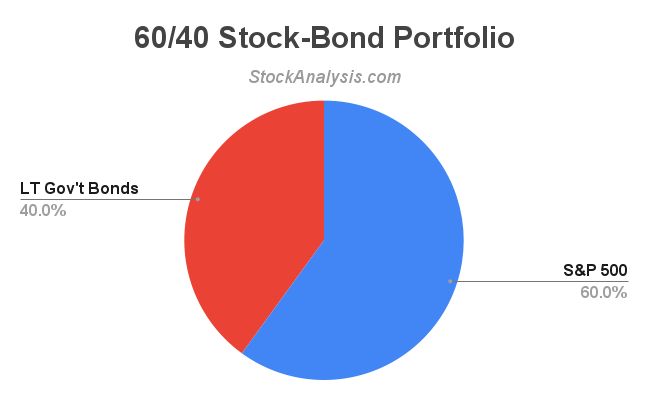
This blended stock/bond portfolio is known for having moderate risk and generating moderate returns.
Potential drawbacks
This approach may be too conservative for younger investors and too risky for older investors.
2. Warren Buffett's 90/10 portfolio
On page 20 of his 2013 letter to Berkshire Hathaway shareholders, Warren Buffett outlined the simple investment strategy he set out in his will for his wife's trust.
- 10% short-term government bonds (like SGOV)
- 90% low-cost S&P 500 index tracker, specifically one of Vanguard's (like VOO)
Not only is this an inexpensive (in terms of fees), well-diversified, and easy portfolio to manage, but he believes it will also outperform the vast majority of investors.
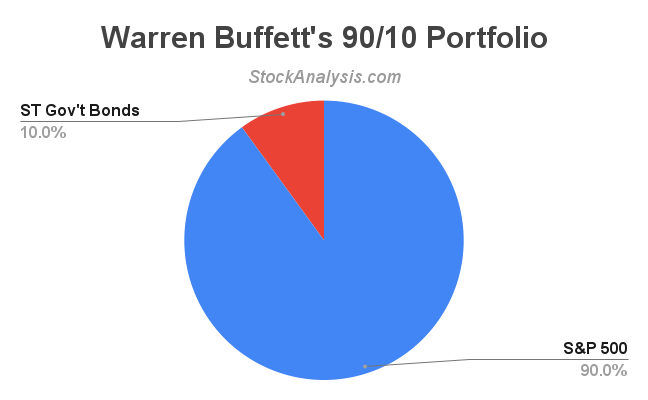
Buffett notes, “I believe the trust's long-term results from this policy will be superior to those attained by most investors — whether pension funds, institutions, or individuals — who employ high-fee managers.”
Potential drawbacks
This portfolio is very stock-heavy and may not be appropriate for older or risk-averse investors.
3. Ray Dalio's all-weather portfolio
Ray Dalio founded Bridgewater Associates, one of the largest hedge funds in the world.
Thinking about which assets perform well under the four economic environments — inflation, deflation, growth, and recession — Dalio and his team constructed a portfolio that you can “set and forget,” regardless of what the future holds.
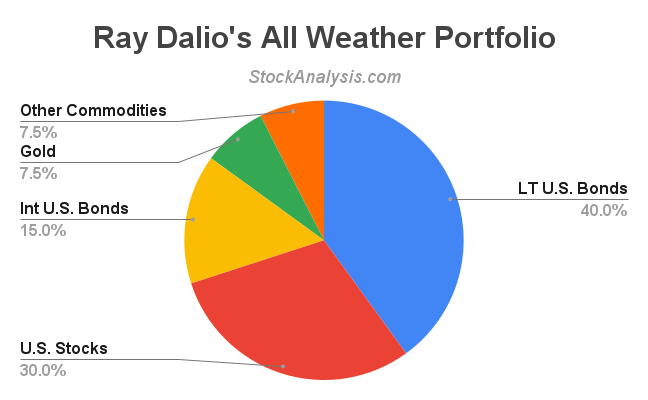
To achieve this mix, consider the following ETFs:
The portfolio has largely achieved its goals of reducing volatility and performing pretty well regardless of the economic environment.
Potential drawbacks
Lower volatility comes with lower returns — the all-weather portfolio has not kept up with stock-only portfolios. Younger investors who can stomach volatility will likely have better results in a less conservative portfolio.
4. Harry Browne's permanent portfolio
Harry Browne was an author and investment advisor who developed the permanent portfolio investing strategy.
The permanent portfolio has the same investment objective as the all-weather portfolio — to perform well under any set of market conditions — but utilizes one less fund.
The portfolio is made up of equal parts long-term U.S. Treasury bonds (like TLT), short-term U.S. Treasury bills (like SGOV), U.S. stocks (like VTI), and gold (like GLD).
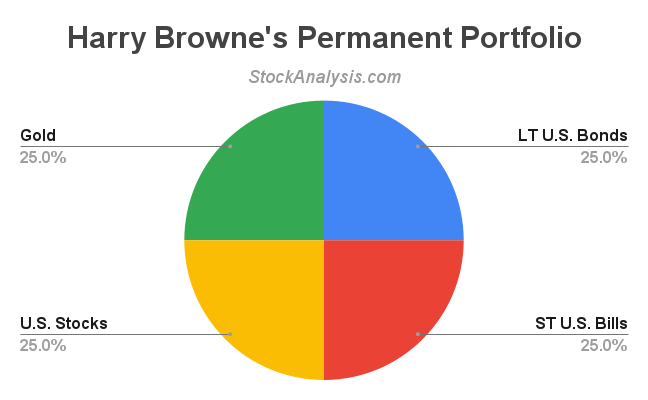
Like Dalio's, Browne's portfolio is known for moderate returns and low-moderate risk.
Potential drawbacks
The relatively small portion of the portfolio allocated to stocks reduces the volatility of the portfolio but also limits its upside.
5. The barbell strategy
The barbell strategy is how we at Stock Analysis invest our money.
We like to invest in individual stocks, which gives us the opportunity to outperform the market, but we also believe Warren Buffett is right about investing passively in index funds.
So, we combined the two into the barbell strategy. My portfolio looks like this:
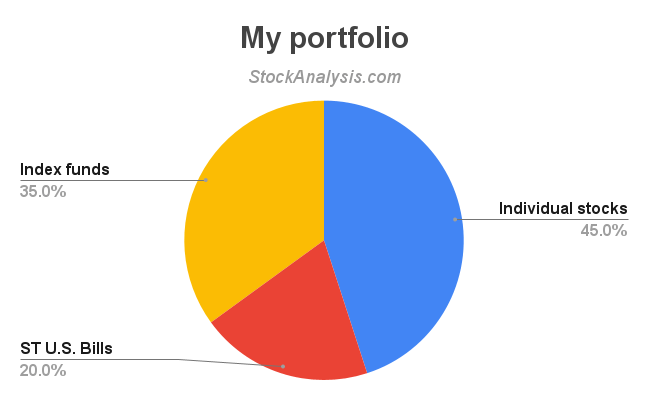
The bulk of my money is in index funds (primarily VOO and VT) and short-term U.S. Treasury bills (SGOV). The rest is in individual stocks.
If you want to know which stocks I invest in and why, you can subscribe to The Barbell Investor.
You get access to my entire portfolio (position sizes, returns, etc.) and can read my in-depth reports about the new stocks I'm adding to my portfolio.
Potential drawbacks
Although it can generate higher returns, owning individual stocks can result in a more volatile portfolio than passive investing.
The takeaway
Diversification is a relatively simple concept that's fairly easy to achieve.
Three expert investors — Warren Buffett, Ray Dalio, and Harry Browne — reinforced that message by recommending easily implementable, diversified portfolios that only require 2–5 ETFs each.
You can diversify further by adding additional asset classes to your portfolio, such as alternatives, or by being more specific about the sub-asset classes you invest in.






